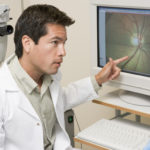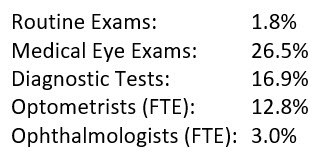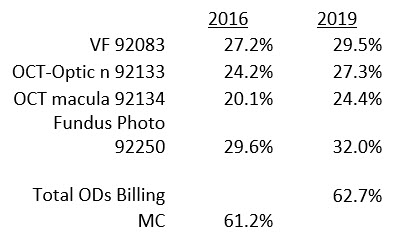
By Richard Edlow, OD,
The Eyeconomist
Nov. 3, 2021
Optometric journals present a plethora of articles covering diagnostic and therapeutic management of eye disease. Based on the coverage, one might assume that the majority of optometrists devote the majority of their clinical time to providing medical eyecare services. To what degree is this true?
I will answer this question below, but, first, let’s take a look at critical data points that will help determine where the entire eyecare industry is headed.
Optometric Growth for Medical Eyecare
There are few professions that have as many robust opportunities for growth as optometry. Routine refractive vision care will continue a slow but steady growth, based on U.S. demographic shifts, resulting in increased demand for exams and eyewear. Practitioners providing behavioral optometry and vision therapy will continue their unique niche. The growing field of myopia management should experience significant expansion as awareness and treatment options expand.
As promising as these practice modalities are, the greatest growth rate for the optometric practice is medical eyecare. What follows is the supply and demand explanation, projections for growth through 2030, as well as hard data on how engaged the profession has been in providing medical eyecare services over the past several years.
Demand Projections for Eyecare Services
There were approximately 111 million routine (refractive) eye examinations delivered in the U.S. in 2020 (VisionWatch data). One can project that by 2030 we need to deliver 113 million exams each year, utilizing age-based U.S. Census data and population growth information.
There were approximately 60 million office-based medical eye exams performed in 2020 (Medicare Utilization & Payment data, Medicare Advantage market share and Commercial insurance estimates). This demand will increase to 76 million annual medical eye exams along with an additional increase of 10 million diagnostics tests to be interpreted.
So, as we compare 2020 to 2030, the collective eyecare industry must be prepared to deliver an additional 2 million routine exams, 16 million medical eye exams and 10 million diagnostics tests PER YEAR. At the same time, the demand for cataract surgical procedures will grow by 1.4 million procedures requiring an increase of 3,500 cataract surgeons from 2020 to 2030 (only 650 new, net increase, ophthalmologists will be added to the field over this entire 10-year period).
Workforce Estimates for Optometry & Ophthalmology
The supply of optometrists and ophthalmologists can be tracked by utilizing enrollment data from the Association of Schools and Colleges of Optometry (ASCO) and residency data from the Association of University Professors of Ophthalmology (AUPO) combined with estimated exit rates (approximately 2.5 percent of each profession exits each year representing a typical 40-year professional career). There are a variety of estimates for the number of practicing optometrists and ophthalmologists; my data supports 47,819 optometrists and 16,865 ophthalmologists in the U.S. in 2021. One can also apply full-time equivalency estimates based on historical survey data.
This decade, optometric programs will, on average, produce 1,800 to 1,900 graduates each year, and 1,200 to 1,300 doctors will exit each year, for an annual net increase of 600 doctors.
Ophthalmology residencies will, on average, produce 490 new practitioners each year, and approximately 430 will exit each year, for a net increase of 60 doctors.
So, in simple terms, we have the following supply and demand growth rates for 2020 to 2030 (note: the growth rates below are NOT annual, but for the entire 10-year period):

The supply and demand data indicate that the ophthalmology workforce will be insufficient to provide for the dramatic rise in demand for age-related eyecare services. Optometry must meet the demand for office-based services as ophthalmology is increasingly driven into the operating room. So, the question raised above is: to what degree is optometry delivering medical eyecare? Unless we are able to capture diagnoses and procedure code data from each and every optometrist in the U.S., we must find some other available data source that can be a proxy for optometry’s medical engagement.
While not perfect, I propose that the best available source is CMS’s Medicare Physician Utilization and Payment (U&P) data. CMS publishes this data each year by physician NPI, provider specialty, CPT codes, quantity billed and paid along with a number of other variables, keeping in mind that any charge to Medicare requires a medically necessary diagnosis. The U&P data is typically released one to two years in arrears. The most recent data available is for 2019. Each year I download the entire report for both optometry and ophthalmology and sort the data along a variety of items. For example, I sort by CPT code, quantity billed and paid, by state, by name, etc.
Other Articles to Explore
There are several ways to interpret the data. One solution might be to count how many optometrists billed Medicare fee-for-service for any code at all. That could include an OD who billed Medicare for a single 92014 (Established, Comprehensive). I would argue that this in no way indicates that the billing provider is actually diagnosing AND treating a medical eye condition.
For example, a 70-year-old established patient comes in for an eye exam. Chief complaint is decreased distant vision. Diagnosis is nuclear sclerosis and increased myopia resulting in visual acuity of 20/25+. The treatment plan is for the patient to return in one year to follow the progression of the nuclear sclerosis and increase the spectacle Rx by -1.00D. Yes, the patient was seen for the medical diagnosis of nuclear sclerosis/cataract and appropriately billed: Medicare for the 92014 and patient responsible for the refraction 92015.
My minimal standard to indicate that there is some level of medical diagnosis AND treatment is that the doctor performed, interpreted and reported on at least one visual field, or one OCT, or one tear film osmolarity, or one fundus photo.
I have been tracking this each year and can report that optometry is, by my minimal criteria, ever so slowly, increasing its engagement in providing medical eyecare services. The chart below indicates what percent of all optometrists billed the Medicare fee-for-service program (Medicare B) for at least one of the listed diagnostic tests in the given year.

While the number of ODs who billed anything, any single item, to Medicare FFS increased minimally, from 61.2 percent in 2016 to 62.7 percent in 2019, I prefer to use as the proxy of engagement in medical eyecare as performing at least one visual field test. Using visual field testing tells us that, while slowly increasing, only 29.5 percent of optometrists perform any meaningful medical eyecare.
The data indicates a solid start, but the profession has significant room for improvement. As this current decade moves forward, the rapidly increasing demand for age-related medical eyecare services must be managed by an ever-increasing number of practicing optometrists. Strategically, I would strongly recommend practitioners act now to acquire a full armamentarium of diagnostic equipment as well as brushing up on the appropriate diagnostic and treatment procedures. Waiting until 2030 is not a viable option for one’s practice or for the public health needs of the aging population.
Interestingly, the recent phenomena of private equity consolidation in the eyecare industry is creating practice models that efficiently combine the best of optometry and ophthalmology under the same roof. This will further help to increase optometry’s inroads into the delivery of medical eyecare.
 Richard Edlow, OD, known as the Eyeconomist, recently retired from clinical care. To contact him: redlow@aol.com
Richard Edlow, OD, known as the Eyeconomist, recently retired from clinical care. To contact him: redlow@aol.com

























